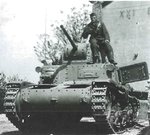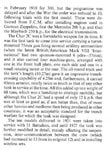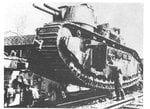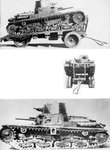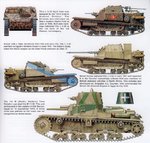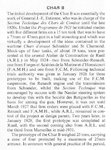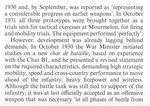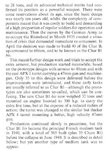Navigation
Install the app
How to install the app on iOS
Follow along with the video below to see how to install our site as a web app on your home screen.
Note: This feature may not be available in some browsers.
More options
You are using an out of date browser. It may not display this or other websites correctly.
You should upgrade or use an alternative browser.
You should upgrade or use an alternative browser.
France/Italy Armored vehicles.
- Thread starter CharlesBronson
- Start date
Ad: This forum contains affiliate links to products on Amazon and eBay. More information in Terms and rules
More options
Who Replied?vikingBerserker
Lieutenant General
Nice CC, looking forward to more info.
- Thread starter
- #3
CharlesBronson
Senior Master Sergeant
Hehe, thanks, lest see if I am worthy of your spectations.
Char 2c, the french Monster.
The development of this massive tank began in 1917 with the foresight of the famous "1919 plan", an allied program aimed to finally break the german thick defensive lines in that year using a large scale attack spearheaded by heavy tanks and armored aeroplanes. It was the heaviest tank ever made until the upcoming of the Tiger II in late 1943. It was the first tank in the world to introduce an medium caliber gun in a fully powered revolving turret.
Char 2c, the french Monster.
The development of this massive tank began in 1917 with the foresight of the famous "1919 plan", an allied program aimed to finally break the german thick defensive lines in that year using a large scale attack spearheaded by heavy tanks and armored aeroplanes. It was the heaviest tank ever made until the upcoming of the Tiger II in late 1943. It was the first tank in the world to introduce an medium caliber gun in a fully powered revolving turret.
Attachments
parsifal
Colonel
The connection to the Char B are obvious.....I think that in hindsight the French should ahve retained the 75 in the turret configuration, rather than opt for the sponson mount
- Thread starter
- #7
CharlesBronson
Senior Master Sergeant
A French Panhard 178 armored car, Eastern Front, Summer of 1941.
Nice picture, after the fall of France teh Panhard was widely used by the germans, even for railway protection.
Aditional information about the fate of the Chars 2c, from Trackstory "Juin 1940 the imposible revival"
Attachments
vikingBerserker
Lieutenant General
That's sad, I always thought it was one hell of a tank.
Shortround6
Major General
That's sad, I always thought it was one hell of a tank.
Hell of a tank for 1919, death trap in 1940.
It might have been 70 tons but it was so big the armor was more like 30mm in many spots. Slow, hard to steer (length to width ratio) and the biggest target on the battle field.
Hell of a tank for 1919, death trap in 1940.
It might have been 70 tons but it was so big the armor was more like 30mm in many spots. Slow, hard to steer (length to width ratio) and the biggest target on the battle field.
True, but an impressive sight nonetheless.
The French weren't bad at building tanks at all, their designs were actually top notch at the beginning of the war compared to the tanks of other countries.
parsifal
Colonel
In terms of armour protection they were probably the best in the world at the time. However they suffered from a number of inherent design faults that are generally well known. The lack of range and mobility (power to weight) are probably the worst elements of their design faults. The single man turrets, the poor design of the cupola, and the lack of radios were all factors in their defeat.
But the most damning reason for their defeat in 1940 was their lack of an adequate doctrine. The Germans knew that they had to keep their armoured units concentrated, and they also knew that the mobility was the key to winning their battle.
If the French had adopted Weygands "quadrillage" defence system from the beginning of the war, and had trained and developed fully armoured corps to counter attack at the german Schwerepunkt the war would have ended in 1940. German tanks were not superior in 1940, but their training and their doctrine was. If only the Frecnh had not lanquished , basking in their 1918 vistory, things may have ended so differently
But the most damning reason for their defeat in 1940 was their lack of an adequate doctrine. The Germans knew that they had to keep their armoured units concentrated, and they also knew that the mobility was the key to winning their battle.
If the French had adopted Weygands "quadrillage" defence system from the beginning of the war, and had trained and developed fully armoured corps to counter attack at the german Schwerepunkt the war would have ended in 1940. German tanks were not superior in 1940, but their training and their doctrine was. If only the Frecnh had not lanquished , basking in their 1918 vistory, things may have ended so differently
Arsenal VG-33
Senior Airman
If only the Frecnh had not lanquished , basking in their 1918 vistory, things may have ended so differently
In all the sources I have, I haven't seen any evidence of this at all. The basking on the 1918 victory lasted perhaps a year before the reality of the heavy costs of the war fell on the people. From recovery, low birth rate, economic depression, political upheaval resulting in civil unrest, and near civil war in at least a couple of cases. The real threat to France was realized when she faced isolation and perhaps even economic sanctions for wanting to evict the Germans from the Rhineland in 1936. With the possibilty of abandonment from her allies, France increased defense production. Certainly exciting times, mixed with trepidation and perhaps a little over confidence in the belief of another German single thrust move, but I cannot find anything indicating some 20 years of languishing and basking in the 1918 victory.
As for that monster, Char 2C, the Germans captured at least one of them, and it is believed that it survived the war and was taken by the Russians. It is rumored to be in the unseen parts of several armor museums in Russia. I've personally seen the Char B at Saumur where it is kept in running condition. They also have a Souma and several other WW 2 French tanks in running condition. There is also a Char B sitting in the Bovington tank museum, where it is is bad shape but restorable.
My personal favorite is the Renault UE Chenillette, which had a tracked trailer, and also towed the 75mm cannon. Neat little bugger. There's actually one in a museum not from where I currently live, and in decent shape too.
Renault UE Chenillette - Wikipedia, the free encyclopedia
- Thread starter
- #14
CharlesBronson
Senior Master Sergeant
You are quite right about the political landscape there VG but some basic desigh failure, like the single man turret, are hardly linked with politics, but more to wrong doctrine.
And talking about failed, check this one.
Carro Armato M-11/39.

In 1933 it was clear the the tankettes were not the answer for replacing the overaging FIAT 3000s and a new tank was commisioned. After experimenting about a bigger and heavier 12 tons tank based on the CV.33 design, a lighter 8 tons tank version was chosen. In 1935 new tank appeared with its 37mm L40 gun with a limited traverse of 15º on the left and on the right and 12º on top and bottom thanks to an hydraulic device on the horizontal plane. The gunner seated on the right and the driver, lightly reared, on the left while the commander manouvered the turret two Breda 8mm MGs. The engine, still of commercial version, transmitted its move through a gear box to the forward sprocket. The drive was possible because of an epicyclic lever and the brakes.
Ground tests demonstrated that the vehicle needed improvements on the engine and transmission systems; a new rounded turret was designed to speed and make easier the production and so, in 1937, the new tank, designed "Carro di rottura" (breaktrough tank) was requested in a first (and only) batch of 100 exemplaries.
Lack of materials delayed the production until 1939 when it begun to be delivered with the signature M. 11/39 (which states for "Medium tank weighting 11 tons and accepted in service in 1939 ): this vehicle was taller, heavier (about 10 tons) and hard to explain the tank was lacking the radio (that instead was mounted on the prototype).
In May 1940 24 M. 11/39s were sent in A.O.I. ("Africa Orientale Italiana", Italian Eastern Africa) grouped in a "Compagnia speciale carri M.", special M. tanks company to reinforce the Italian positions in the colony. On the start of the conflict field commands required new tank reinforcements because the light CV. 33s were unuseful, as demonstrated in first encounters with British armored units. 70 tanks were placed at disposal of the 4th Tank Regiment and landed in Bengazi in July of the same year.
When first employed against the English the M.11/39 got enough succes while being used in infantry support role during the first advance to Sidi Barrani. Similarly to the L. 33s this tanks were mechanically unreliable: in September when the Armored Groups were re-created the I Battailon of the 4th Tank Regiment's 31 tanks only nine were still in service. The first engagements with the british tanks immediatly proved the inferiority and weakness of the M.11 in both gun and armor thickness and shape, without speaking about the weak trasmission/suspension system.
The disaster was near: when the British launched their offensive in December 1940 the II Bataillon (2 M.11 companies) detached to Maletti Group was surprised near Nibeiwa and 22 of its tanks were knocked out. The I Battailon, while being part of the new Special Armored Brigade with a M.13 Battaillon and 2 L.33 battailons, was able to take only a minor part in the fight because the most part of its tanks were in Tobruk for repairs.
The following defeat in early 1941 took the destruction or the capture of almost all the M.11/39s: because of their unreliability and lack of any recovery vehicle the immobilized vehicles were abandoned in the enemy hands: the Australians equipped an entire regiment with the captured M.39 but they were soon put out of service because of their faults. The remnants six tanks were used in Italy for training purposes and were officially put out of service after the armistice of September 1943.
And talking about failed, check this one.
Carro Armato M-11/39.

In 1933 it was clear the the tankettes were not the answer for replacing the overaging FIAT 3000s and a new tank was commisioned. After experimenting about a bigger and heavier 12 tons tank based on the CV.33 design, a lighter 8 tons tank version was chosen. In 1935 new tank appeared with its 37mm L40 gun with a limited traverse of 15º on the left and on the right and 12º on top and bottom thanks to an hydraulic device on the horizontal plane. The gunner seated on the right and the driver, lightly reared, on the left while the commander manouvered the turret two Breda 8mm MGs. The engine, still of commercial version, transmitted its move through a gear box to the forward sprocket. The drive was possible because of an epicyclic lever and the brakes.
Ground tests demonstrated that the vehicle needed improvements on the engine and transmission systems; a new rounded turret was designed to speed and make easier the production and so, in 1937, the new tank, designed "Carro di rottura" (breaktrough tank) was requested in a first (and only) batch of 100 exemplaries.
Lack of materials delayed the production until 1939 when it begun to be delivered with the signature M. 11/39 (which states for "Medium tank weighting 11 tons and accepted in service in 1939 ): this vehicle was taller, heavier (about 10 tons) and hard to explain the tank was lacking the radio (that instead was mounted on the prototype).
In May 1940 24 M. 11/39s were sent in A.O.I. ("Africa Orientale Italiana", Italian Eastern Africa) grouped in a "Compagnia speciale carri M.", special M. tanks company to reinforce the Italian positions in the colony. On the start of the conflict field commands required new tank reinforcements because the light CV. 33s were unuseful, as demonstrated in first encounters with British armored units. 70 tanks were placed at disposal of the 4th Tank Regiment and landed in Bengazi in July of the same year.
When first employed against the English the M.11/39 got enough succes while being used in infantry support role during the first advance to Sidi Barrani. Similarly to the L. 33s this tanks were mechanically unreliable: in September when the Armored Groups were re-created the I Battailon of the 4th Tank Regiment's 31 tanks only nine were still in service. The first engagements with the british tanks immediatly proved the inferiority and weakness of the M.11 in both gun and armor thickness and shape, without speaking about the weak trasmission/suspension system.
The disaster was near: when the British launched their offensive in December 1940 the II Bataillon (2 M.11 companies) detached to Maletti Group was surprised near Nibeiwa and 22 of its tanks were knocked out. The I Battailon, while being part of the new Special Armored Brigade with a M.13 Battaillon and 2 L.33 battailons, was able to take only a minor part in the fight because the most part of its tanks were in Tobruk for repairs.
The following defeat in early 1941 took the destruction or the capture of almost all the M.11/39s: because of their unreliability and lack of any recovery vehicle the immobilized vehicles were abandoned in the enemy hands: the Australians equipped an entire regiment with the captured M.39 but they were soon put out of service because of their faults. The remnants six tanks were used in Italy for training purposes and were officially put out of service after the armistice of September 1943.
Attachments
- Thread starter
- #15
CharlesBronson
Senior Master Sergeant
Characteristics M-11/39:
Weigth: 10,970 tons
Crew: 3
Weapons: Vickers-Terni 37mm L40 gun with 84 rounds, 2 8mm MG Breda model 38 with 2800 rounds.
Armor: hull 8-30mm (nose 30mm, sloped plate 14mm, front 30mm, sides 14-15mm, top 8mm, bottom 7mm, rear 14mm); turret 7-30mm (front 30mm, sides and rear 14mm, top 7mm).
Engine: 43hp diesel FIAT Spa 8T, 8-cylinders on V, liquid cooled
Speed: 34Km/h
Autonomy: 200Km
Length (max)4,73m
Width: 2,18m
Height: 2,25m
Plate from "Italian Armored Vehicles of WW2" Squadron Armor. Gallery of light and Medium tanks, note the 20 mm AT rifle armed tankette.
Weigth: 10,970 tons
Crew: 3
Weapons: Vickers-Terni 37mm L40 gun with 84 rounds, 2 8mm MG Breda model 38 with 2800 rounds.
Armor: hull 8-30mm (nose 30mm, sloped plate 14mm, front 30mm, sides 14-15mm, top 8mm, bottom 7mm, rear 14mm); turret 7-30mm (front 30mm, sides and rear 14mm, top 7mm).
Engine: 43hp diesel FIAT Spa 8T, 8-cylinders on V, liquid cooled
Speed: 34Km/h
Autonomy: 200Km
Length (max)4,73m
Width: 2,18m
Height: 2,25m
Plate from "Italian Armored Vehicles of WW2" Squadron Armor. Gallery of light and Medium tanks, note the 20 mm AT rifle armed tankette.
Attachments
- Thread starter
- #16
CharlesBronson
Senior Master Sergeant
The Char B1:
This tank was France s main battle tank at the time of may 1940. It clearly exemplify the virtues and vices of all french armor in ww2, an excellent, innovative design with several technical values, delicatedly manufactured, powerful weapons and heavy armor, however the bad crew layout and duties made it a nightmare of command and control in the battlefield.
( AFV Profile, French heavy tanks, 1971)
This tank was France s main battle tank at the time of may 1940. It clearly exemplify the virtues and vices of all french armor in ww2, an excellent, innovative design with several technical values, delicatedly manufactured, powerful weapons and heavy armor, however the bad crew layout and duties made it a nightmare of command and control in the battlefield.
( AFV Profile, French heavy tanks, 1971)
Attachments
- Thread starter
- #17
CharlesBronson
Senior Master Sergeant
Close up to the cast steel APX ( Atelier PuteauX) turret, the Char B1 47mm gun had a muzzle velocity of 630 mps, enough to deal with every german panzer of the period.
Note the periscopic binocular gunsight. and the coaxial Reibel MG 7.5 mm emplacemet, the MG could be used freely in its mounting, it had no remote firing but a normal handgrip.
Note the periscopic binocular gunsight. and the coaxial Reibel MG 7.5 mm emplacemet, the MG could be used freely in its mounting, it had no remote firing but a normal handgrip.
Attachments
vikingBerserker
Lieutenant General
Very cool! Always loved that tank.
- Thread starter
- #20
CharlesBronson
Senior Master Sergeant
Panhard 178 armored car, on which Piet posted a photo, was a good one. Germans widely used them, IIRC for ex. the armoured recce battalion of 7. PzD was equipped with them during Oper. Barbarossa in 1941.
I have an excellent color footage of the Panhard "panzerspähwagen" in german service, is included in the DVD "Mit der kamera an der Ostfront", an gift from Papa Noel, local variant of Santa Claus.
Very cool! Always loved that tank
Thanks, some data on the improved 1940 variant.
Char B1 ter:
Aparently the B1 ter as a design to improve the difficulty manning in the B1 bis, but still a more cheaper option to the B2 wich was to be armed with a fully revolving 75 mm plus 2mgs armed turret.
The B2 should had a better characteritics and to cure some of the vices of the french design, however it was seen as an expensive vehicle, the option to improve the existent B1 bis was choosed instead.
B1 ter development began in 1936, the Chief inspector of the french armored forces, General Velpry, insisted in a improved armor for this tank. That was materialized in a well sloped 75mm frontal plate ( wich included a combined riveted-welded construction) and a side 60mm rolled plate with a "V" shape, protecting the vital parts of the tank. Renault provided a engine 15 % more powerful to cope with the increased weight.
Finally, at last, in this design the driver was liberated from the task to fire the hull howitzer, however it still had a important part aiming it because the azimuth was extremely limited. The B1 ter transmision was a simple differential , a more easy and less complex tha the earlier Naeder double differential. In all and despite to have the devilish single place turret the Ter was a more simple, valuable and workable design than its predesessors.
150 were ordered in 1938, unfortunately for France, economical cutbacks caused than only 3 prototypes were available in may 1940, those used for testing in the Saint Nazaire garrison.
Characteristics:
Manufacturer: Atelier de Construction de Rueil (ARL) , Forges et Chantiers de la Mediterraine (FCM)
Crew: 4, chief/loader/gunner, loader/hull gunner, driver, radio operator.
Hull lenght: 6.35m
Hull gun azimuth: 6º left and right
Width: 2,73 m
Height: 2,83 m
track width : 500 mm
Suspension: coil springs
Weigh in battle order: 36600 kg.
Engine: Renault 6 cilinders gasoline water cooled, 350 hp.
Speed road: 30 km/h
Armor: between 30 to 75mm.
Armament: SA 35 de 47mm in turret ( muzzle velocity 662 mps) with 60 rounds, 75mm howitzer ( muzzle velocity 220mps) with 80 rounds, Chatereault 7,5 mm machinegun with 600 shots.
Attachments
Users who are viewing this thread
Total: 1 (members: 0, guests: 1)

